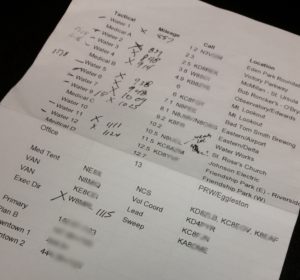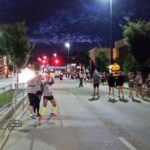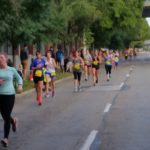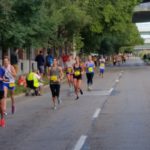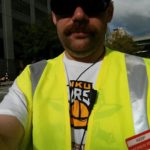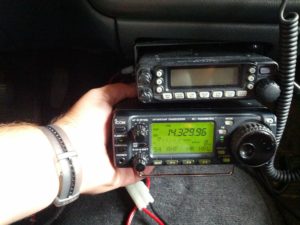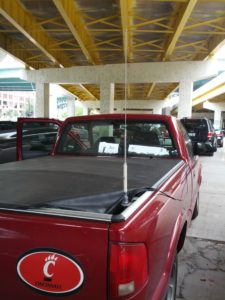Category Archives: Operating
I’m a runner, but you didn’t stray to my other website and I didn’t accidentally post running stuff to the wrong website. This is about volunteering to help at a race, specifically the Queen Bee Half Marathon and 4 Mile Race.
The position I’ve had at this race is shadowing the race director (RD). I’ve been doing this for four years now, so this is the accumulation of all that knowledge.
Preparation
Obviously, charge both my HTs and gather related equipment (headsets, backup batteries). One of my HTs is a Wouxun, so check the programming (I do this early using last year’s frequencies and CTCSS tones and then check for any changes when the frequencies are released; CHIRP makes it easy to deal with this).
Since my position involves telling the race director about the progress of the race, I created a cheat sheet of tactical names, mileage, and callsigns. This way, I can tell the RD a location better than “water 4”.
The cheat sheet was nice to have – particularly because I was telling the RD things like “lead runner at mile 1.2” as opposed to “water 1”, which is a little past the marked mile. Additionally, I put a tick mark next to people as they checked in and noted the time when they were released.
Other stuff I tend to have with me:
- Small memo pad
- Pen
- Pocket knife
- Glasses wipe
- Hat (damn receding hairline and general baldness!)
Race Day
I arrive before my scheduled time, mostly because I park at my office (free, secure, and right where I tend to be released from). Find the RD (I know generally where to look, and know who to ask that can get me pointed towards him), and make sure he sees me (if he’s busy). I generally wait until this time to check in with NCS (net control station) as sometimes questions come in. If there are things the RD is doing that I can help with, I jump in and help.
The first race to start is the half marathon. After a half hour, the 4 mile race starts. This year (different from years past), I broadcast the count-down to the start of both races. The remainder is telling the RD where lead runners are and if there are any issues and relaying questions that need to be relayed. Fortunately, many of the stations have been doing this as long as I have (as long as the race itself), so there aren’t many questions anymore as we’ve all refined the process a little – for example, NCS makes sure I know if the lead runner is male or female (since this is the QUEEN BEE half, they would like the first finisher to be female).
Beyond that, I make sure the RD knows if there are a lot of runners dropping out or if I hear anything on the air that I think he needs to be aware of, but since this is become a well-oiled machine and the weather usually cooperates, there hasn’t been much.
Random Pictures
If I did this blog post when I should have, I likely had a reason for taking most of these. However, the race was in October and it’s now February, there’s no way I remember why I took these.
- Before the start
- Before the start
- Before the start
- Presenting the flag, just before the start
- Prep for the start
- Prep for the start
- The finish line for the 4 mile race moved, so the old finish line had this banner.
- Four mile finishers
- Four mile finishers
- Cars coming from Cars and Coffee down the road
- Cars coming from Cars and Coffee down the road
- Cars coming from Cars and Coffee down the road
- Cars coming from Cars and Coffee down the road
- This guy gets it…
- Me. Wearing a running shirt and a vest that is far too large for me because I’ve lost a shit ton of weight!
Since my year will be full of a lot of traveling (a lot more than in prior years), and I still want to get into actually using CW, I decided it would be smart to have a quick reference of QRS nets to help me out.
I haven’t verified that any of these exist, and I’m quite certain there’s a few more out there. But here it is: ![]()
![]()
![]() . If I missed any, please let me know in the comments or via email at ke8p .–.-. ke8p .-.-.- us
. If I missed any, please let me know in the comments or via email at ke8p .–.-. ke8p .-.-.- us
-73-
Last Friday while sitting in the parking lot of my building, I tried contacting NR4CB or AB4UG to wish them a happy wedding day. It didn’t happen. I could barely hear Connie, could tell someone was there (but couldn’t make out the words) when Eugene was on. It didn’t help that other stations were 2 kHz above and 2 kHz below.
I got to thinking about running mobile HF again.
It looks like I need to fashion a pair of brackets – one would be simple, and the other complex a little. I do have the mobile bracket for my 706, so I can always use that as a guide for holes.
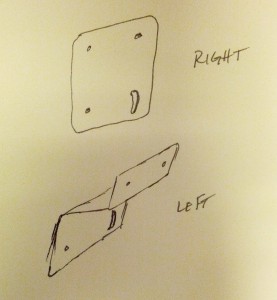
It seems far simpler when it is a sketch on a post-it note than when it is a piece of sheet metal that has to fit.
Another thought with the brackets is that I don’t *have* to have the radio there. I need the head there, but I do have the head separation kit, so I can always put the radio elsewhere and run power and antenna to it.
The other thing I looked at was the antenna. Like every other self-respecting ham, I feel as if antennas should be big. I was concerned about this 20m antenna and a quick look at K0BG’s website confirmed my suspicions.
The antenna is so small compared to 5 meters (roughly a 1/4λ for 20 meters) that it has to be basically a dummy load on a stick. I’m not sure if the bridge above me helped or hurt; I had thought about driving up to Mt. Adams, but for various reasons I couldn’t stray too far. I’ll have to try again. I need to run the antenna wire (I’m not sure other vehicles would like the idea of me having that coax flapping around, and I can’t have the tonneau cover open like it is when I’m stationary.
The last consideration is power, but it isn’t a huge consideration. I have a power line that is safe for 20 amps (as much as my 706 needs), but I don’t want to have to unhook/rehook power connectors (those ARE live, after all). I’m thinking I need a miniature power distribution center with two pair of fused power poles and a master switch, and maybe a battery shutoff.
-73-
I wouldn’t say I feel a lot like the Grinch at the end of the movie (where his heart grows 3 sizes in the matter of 30 seconds… which is probably a pretty painful experience, even if you aren’t the most belligerent asshole in all of Whoville), but I feel a change going on.
When I started back into amateur radio a few years ago, I already had a lot of respect for the QRP guys because they did more with less. However, I had little interest in going down to low power. I felt as if I should stick to my barefoot 100W, and I’ve been contemplating getting (or more likely building) a 250W amp. Not really QRO, but more QRO than QRP.
In the past many months, I have been making progress learning CW. I also keep seeing things out of several twitter friends and blog posts where they’re out having fun doing things like QRP Foxhunts and other QRP-only contests. Heck, even just some of these people getting out to a park or something and operating for a few hours looks like fun (and some of this stuff I could do on my lunchbreak). And if the past 2 years in amateur radio have taught me anything about myself, it is that my favorite operating mode is CONTESTING! I don’t care about winning, but I really enjoy the rapid-fire exchanges the battle against QRM, QRN, and my knowledge of how to use my equipment.
I will say that it helps the QRP cause when I see twitter updates along the lines of “I really had fun in the QRP Foxhunt last night” and I see others blogging about the fun of doing some of the sprints, or even just people sharing pictures of operating in remote locations.
So I’ve decided that my next rig will be a QRP rig. It isn’t going to be soon – I don’t have the money to spend on it and I’m still learning CW. But it isn’t going to be in 10 years, either, since I very well could just build me one (and I probably will since I’m just about broke). I’ll probably become a member of some of the QRP groups out there sometime. I’m a new member of NAQCC (#6570) and SKCC (#10489).
I’m not getting rid of my ‘706, though. I will still maintain the capability to run some power for various reasons, and I may go through with building that amp one day. But my priorities are set, they’re really set on fun and joining the friends I’ve made via twitter on the air. Mostly having fun.
-73-
There was a conversation going on via Twitter related to learning CW. I saved all of these to Evernote and came back and added them via Storify. Twitter doesn’t have a great way to save these for the future, so hopefully being published in a Storify Story will keep these golden nuggets of advice around for a long, long, long time.
A note on the last one – it doesn’t look like CW advice, but it most certainly is. It is actually a little bit more, but it is well within the subject of this blog post.
Me? I’m currently sitting at being able to do around half the alphabet. I’ve been extremely busy for the entire month and haven’t even had much of a chance to open the lid of the laptop except to prepare for a class I teach at the University of Cincinnati. Things are starting to die down and fall into place now, so hopefully I can get some time to sit down and bring up lcwo.net.
Have any additional advice? Leave it in the comments below!
-73-
Some of us in the Cincinnati area (well, so far, we’re all on the east side, but hopefully we’ll get some more in the area) have decided to learn CW. We’re going to start a net (of sorts) to help get us rolling. We don’t know exactly where on the bands, but probably in the Tech voice portion of 10 meters in the evenings or somewhere on 2 meters. Yes, I know it says “SSB Only” on the 10 meter band plan for techs, but CW is one sideband and a suppressed carrier! This allows us to be able to talk and send.
Right now, there are three of us involved, one general and two extras. If you happen to live in the Cincinnati area and want to get involved, please jump over to the TriStateHams website and answer the poll.
If you follow me on Twitter (@KE8P) or Google+, you may have already seen my ‘redneck code practice oscillator’ video, but if you haven’t…
hihi…
-73-
Over the past week, I did a service event with CARES (Clermont Amateur Radio Emergency Service) roving around at the county fair. This was done in conjunction with the county sheriff’s department, who likes to have some extra sets of eyes around.
An event like this involves a lot of walking around, and doesn’t always lend itself to a normal “go pack” that would fit in a backpack, since the added weight would feel really heavy (no matter how light). In addition, since we’re talking about a fair, there is a lot of people and amenities around, so we don’t have to be in “survival” mode. However, during the week (on just about every day), we’ve been hit by strong thunderstorms, and my night at the fair was no exception.
Prep: Attire
During the days here, the temperature has been hitting the 90s, so shorts and short sleeves was the order of the day. We have vests to wear as well. Fortunately, our vests have pockets on the inside and outside (a definite plus!). The vests also have a pocket in the back that was excellent for a rain coat. Of course, I had shoes on, but the not-very-smart thing I did was use my nicer running shoes (instead of the older running shoes I use when I mow the lawn). Either way, comfortable athletic shoes were the best to go with.
Prep: Stuff
The things that worked was my Wouxun dual bander, speaker/mic. I had a battery pack with AAs in my back pocket.
The thing that could have worked better was my earphones that I was using with the speaker mic – I had a stereo set and one side did not work. Also, the cord was way too long.
What did not work at all was the water bottle I brought. I had one that was refillable, and being out and away from the truck meant that I had to carry it with me. I should have brought a disposable bottle with me that I could dispose of when it was empty (there was no good place to refill the bottles).
I also had a small notepad, two maps of the grounds, a pen, and my EMA ID card (along with my normal driver’s license and amateur radio license). Most (if not all of that) should go without saying.
Prep: uh… prep!
This goes without saying, but MAKE SURE YOUR RADIOS ARE CHARGED! Nothing makes you look worse than having your battery die in the first hour. I recommend having two radios, both charged, and also having a spare (charged or AA) battery pack.
Make sure your frequencies are in memory, and set the radios to that memory prior to turning off the radio when charging (most will remember the frequency). This goes double for radios like Wouxuns that are notoriously known for being difficult to program in the field.
Landing
When you get to the location the first and obvious thing is to check in (following the protocol of your group).
Remain observant. I was there when I almost needed to call for a medical unit (fortunately it came out to be nothing).
Be where the people are. My partners in fighting crime (the other CARES ops) saw a fight and because they were where the most people were (at the grandstand watching the demolition derby). That doesn’t mean to ignore the rest of the complex, just make sure those places are covered (another great reason to wear bright-colored vests, as it makes it easy to see where others are).
Next up: HFP race event.
-73-
Now that I’m done cussin’ at the software (which was doing what it was supposed to, I just didn’t realize that), I have some time to reflect.
First off, 15 and 20 meters were awesome. 10 meters stunk for me – lots of calling from CA, but nobody was hearing my 25 watts from Ohio. 40 meters looked good as well. More on that in a second.
I netted 960 points in 40 QSOs. Two new DX – Cuba and the UK. One #WATwitter – @VA5LF.
I started on 20 and got several. Went to 10 (I think I got one Q there), went to 15 and tore it up. Back to 20, found a few new. Jumped to 40. On my 3rd QSO on 40 my rig quit. Just quit. I thought it had folded back (like it had high SWR). So I turned the rig off and back on. The rig lit up for a split second before dying again. Tried it again, same result. Again. Again. Put my hand on the heat sink on the back. I did NOT yell “ouch!” (or anything of the sort). It was warm, but not hot. Did the same to the power supply, and the same result. I unplugged everything and took the rig over to the bench and removed the covers. Nothing looked burned or bad, but I couldn’t see in the finals. Figuring that’s where the problem would be, I uncovered the finals. Nothing.
So I replaced the bottom cover and moved the rig aside and got the power supply. I tried to pull a pass transistor off the back, but after trying to pry it off with a knife I realized it was soldered on. So I replaced the screws on the pass transistor and plugged it back in to try and put a load on it. After plugging it in at the bench and turning it on, the transistor that I was trying to pry popped from the location I tried to pry it from.
So at least I know I have a bad pass transistor. Maybe two. The rig condition is unknown. I’m going to get a battery and hook the rig to it and see if the rig runs. I honestly don’t want to hook my Astron PS to it, as I don’t want it to blow if there is something wrong with the rig.
-73-
I recently co-instructed a technician class (one of four or five sessions) and this is a few resources for the students as well as any new ham. I am going to try to keep this up-to-date.
First off, I think all new hams should read this article by Chris Seright KE5ZRT. He does a great job of what you should do now that you have a license.
Second off, the stuff below is a laundry-list of clubs, emergency groups, nets, and other items of interest to new hams. It is specific to Clermont County and the Cincinnati region. This is not all-inclusive!
Local Cincinnati Clubs
Milford Amateur Radio Club (we’re teaching this, so they get the plug!) (Facebook) (Twitter)
Other Cincinnati Clubs (Courtesy of WARN)
Local Cincinnati Emergency Groups
Clermont Amateur Radio Emergency Service
Weather Amateur Radio Network (Twitter) (Facebook)
Traffic Networks
Other Local Nets
Milford Amateur Radio Club Weekly Net – 9:00PM Local Sunday 147.345
OH-KY-IN Tech Talk Net – 9:00 PM Local Wednesdays 146.67
Ham Twit Net (Ham Radio Operators on Twitter) – Echolink W5RAW-R #387265 0100 UTC Thursdays
(in Cincinnati, winter 8:00 PM, summer 9:00 PM)
Maps and Band Plans
ARRL Band Plan (the legal band plan)
ARRL Band Plans (the Gentlemen’s Agreements)
Grid Square Map – Google Maps – PDF – printed copies available at most ham radio retailers
CQ Zone Map – ITU Zone Map – better printed copies available for free at most ham radio retailers
Podcasts
The Practical Amateur Radio Podcast – great operating resources, the author talks about different ways to have fun with radio
Amateur Radio Newsline – Amateur Radio News
Ham Nation – weekly feature show on the TWIT network featuring Bob Heil and Gordon West
Linux in the Hamshack Podcast – for those interested in Linux
Major National Clubs
Other Web Resources
QRZ – call lookup for QSL info, bios, etc. Also forums, other related.
eHam.net – Forums, news articles
Local Ham Radio Retailers
R&L Electronics – Hamilton
Universal Radio – Reynoldsburg (near Columbus)
AES – Cleveland
DX Engineering – Akron
Note: there are several others that ship and take ordering over the Internet – Google is your friend here, as is QST or CQ magazine.

